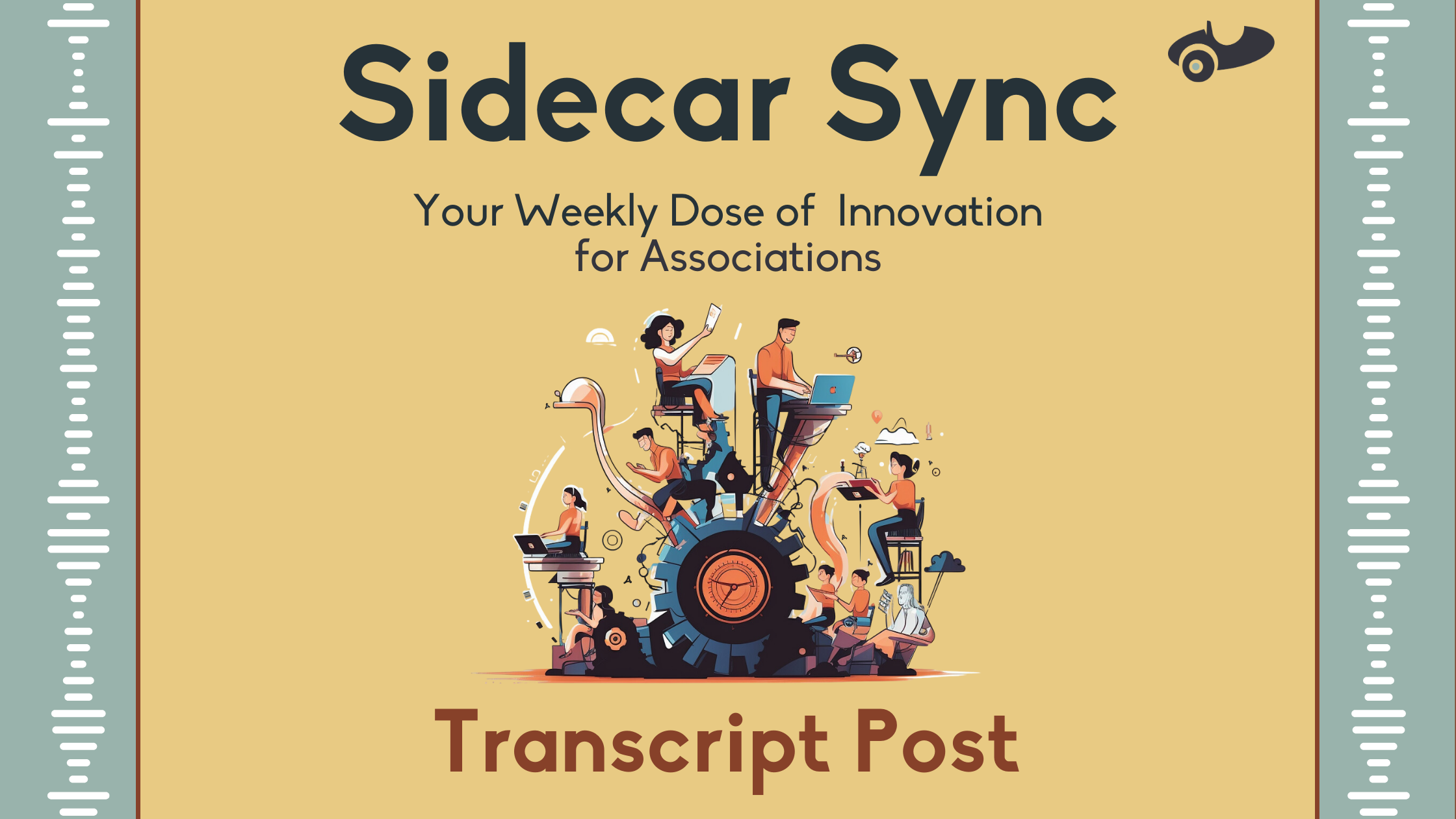Association leaders have a litany of skills and experiences that ensure they’ll succeed in their role – from knowing how to retain members to business acumen that generates non-dues revenue.
However, that’s only one piece of the puzzle when it comes to a successful association career.
The other half? The emotional intelligence that allows leaders to connect with their staff, the organization’s missions and the success of the members and communities they serve.
Emotional intelligence is a key leadership trait that empowers people to recognize, understand and manage their emotions as well as the emotions of those around them. While some folks in your organization may be naturally empathetic and find that connection more easily, it’s often a skill that needs to be developed.
So how do you go about building your emotional intelligence?
Why Is Leadership EQ Important?
Before we dive into the “how” of developing emotional intelligence, it’s essential to know the
“why.” EQ does more than allow for better connections or inform better decisions. Leaders with higher emotional intelligence also see measurable benefits across many common KPI areas.
According to a study from TalentSmart, when compared to 33 other workplace skills, emotional intelligence was the strongest predictor of performance, with a 58% success rate in a role. And these trends also show up in hiring, with 71% of hiring managers valuing EQ more highly than IQ.
Similarly, high EQ can impact organizations and leaders financially. According to a Harvard Business Review study, companies that ranked higher on their Global Empath Index generated 50% more earnings and increased their value twice as much as companies at the bottom of the list.
Related: How Do You Assess the Emotional Intelligence of Potential Leaders?
Learn More >
10 Strategies to Build Your Emotional Intelligence
So if emotional intelligence can help you connect with your team, perform better and even land better jobs, how do you improve it? Like most leadership skills, association leaders can build emotional intelligence with intentionality and consistency. Here are ten ways to get started.
1. Improve Your Self-Awareness
One of the most critical skills for building emotional intelligence as a leader is self-awareness. This means being conscious of your feelings, actions and reactions to different situations. Reflecting on how you’re feeling in each moment can help you better understand yourself and those around you.
This self-awareness can be critical in making it safe for your staff to be authentic and vulnerable without judgment from leadership.
Related: Is Authenticity Missing From Your Leadership Strategy?
Learn More >
2. Learn To Recognize Your Biases
Whether you realize it or not, everyone has some kind of bias based on their experiences, beliefs or preferences – no one is immune from it! But by becoming aware of these biases, you can learn how they may influence your decisions as a leader (and ultimately shape your team's culture).
One way to do this is by reflecting on past challenges that didn't go according to plan and asking yourself if any underlying biases at play affected the outcome. For example, was a new idea ignored simply because that staffer didn’t have a specific amount of work experience? Or did you gloss over someone's resume because they attended a rival school?
Not only can these biases impact the growth of your staff, but they can also impact your association's overall reputation and culture.
3. Practice Thoughtful Self-Regulation
Another critical aspect of emotional intelligence is the ability to regulate emotions. No matter your industry or role, chances are you’ll run into a stressful situation – from difficult conversations with direct reports to an irate member. This is where self-regulation and remaining calm under pressure can help differentiate you from other leaders.
From mindfulness practices like yoga or meditation to simply working on your breathing before responding, taking a beat before diving into those emotionally charged situations can help.
4. Engage With Active Listening
Listening is just as essential as speaking, particularly when it comes to building strong relationships. However, a mistake that’s often made is listening to respond and not to understand.
What does this mean?
Whether we realize it or not, we often check out the moment we have a point to make or an answer to a question being brought up. But, this often leads us to ignore or miss the most critical information in the conversation.
At a minimum, active listening involves hearing what others say without passing any personal judgment and avoiding interjecting comments continuously. Additionally, you should always look to avoid distractions like waving at someone passing in the hall or checking another screen while on a zoom call.
Additionally, you should always look to:
- Paraphrase what was said.
- Summarize key points.
- Ask relevant questions for clarification.
- Provide feedback and respond to any concerns in a respectful manner.
5. Pay Attention To Nonverbal Cues
Another part of active listening is observation!
Nonverbal cues – facial expressions, body language, tone of voice – can give you valuable insight into how someone might feel underneath the surface in any given situation. Not only can it help you better relate in those one-on-one conversations, but nonverbal cues can also clue you into the vibe of a room – particularly during difficult conversations, when discussing sensitive topics or making important decisions.
For association professionals, this is particularly valuable for those c-suite conversations or when making presentations to your membership.
6. Strengthen Social Competence
To ensure successful leadership, strong social competence is key, meaning having the ability to interact comfortably with people from all walks of life while demonstrating respect and maintaining healthy boundaries.
While what is said (and observed) is important, so are the things that aren’t. As a leader with high EQ, you should consider all elements that influence an interaction – culture, relationships between parties and current events or climates that may affect people’s emotions and responses.
Similarly, the power dynamics within the workplace are just as important. Who has what kind of power (e.g., positional vs. social) over whom? Not only can this impact the honesty or amount of information being provided, but it can also influence decision-making processes and other activities within the organization.
It’s a lot to be aware of, but the better your understanding of your situation, the more effective you can be for your team and organization.
7. Learn Conflict Management Skills
When do emotionally intelligent leaders shine? When things are the toughest. And conflict resolution is more challenging. However, this situation will often fall on leadership, and being prepared is critical.
It’s important to be able to identify the issue, look for solutions (whether that’s a compromise or an accommodation), have the temperament to safely and effectively bring everyone to the table and most importantly, the focus to follow-up and remain a support resource for your organization.
8. Become Flexible with Your Thinking
For associations, traditional thinking can often be challenging – whether it stems from your governance or leadership. Leaders with high emotional intelligence can think flexibly to adapt their approach depending on their context or situation. This means looking beyond rigid processes or ways of thinking that may not be suitable for a particular moment or conversation – instead opting for an approach more appropriate for the circumstances at hand.
Similarly, remembering to remain impartial during difficult conversations keeps you in that non-judgmental mode even when there are diverging opinions. Outside of maintaining workplace tensions at a low, it also fosters collaboration, creating an environment built around openness, where teammates feel safe expressing ideas without fear of contradiction or retribution.
Related: 5 Change Management Best Practices for Maximum Success
Learn More >
9. Display Assertiveness When Necessary
While you should always work to remain understanding and impartial, you still need to know when to take the reins. Assertiveness encourages direct yet respectful communication – something leaders should strive towards when addressing issues.
An assertive stance may not be your go-to at all times, but when the situation merits it, you should be able to establish expectations, follow up with your team and hold them accountable for any adjustments needed.
10. Ask For Help
Finally, and often most importantly, leaders need to know the value of asking for help.
You may be focused on building your emotional intelligence, but you don’t know everything. Whether dealing with a difficult conversation, solving a conflict amongst staff or figuring out how to keep your emotions in check, asking for help is a clear sign that you’re ready to do the work.
Whether that’s from a coworker, leader or anyone you trust, being open and willing to learn is a great way to build your EQ.
The Future of Emotion-Forward Association Leadership
As more organizations prioritize authenticity and vulnerability amongst their staff, it’s important to remember that these skills take work to develop. While there is no hard and fast rule on how to build emotional intelligence, there are some places association leaders should focus on.
For starters, gaining self-awareness is critical. Understanding your own emotions, biases and the impact that outside influences can have on interactions within your organization can go a long way to finding common ground. Similarly, working on interpersonal skills like active listening and conflict management can help association leaders tackle those difficult situations with grace and understanding.
The bottom line is that emotionally intelligent leaders can have a massive impact not only on the culture and success of your association but, more importantly, on the staff and members they serve.
Jose Triana
Jose Triana joined the Sidecar team as the Content Manager in 2021. He is a writer and creative focused on helping purpose-driven organizations learn and find value online. When he isn't working on content, you can catch him going for a run or resting with a good book.







